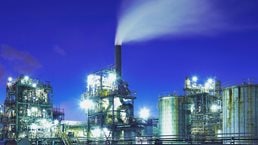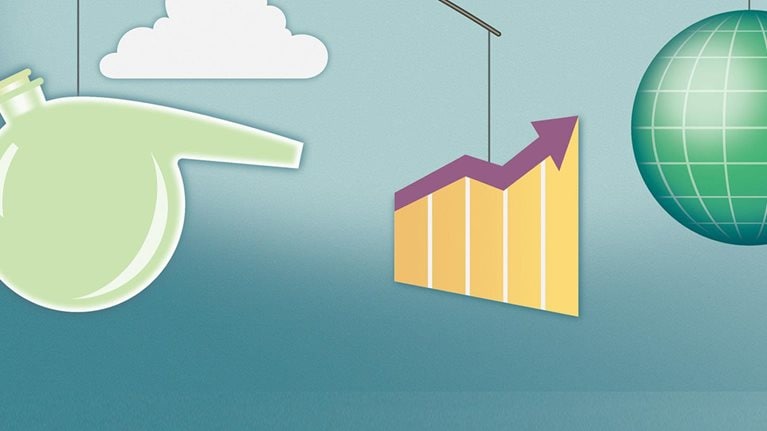The combination of stock markets at record highs and a generally favorable outlook for the global economy has created a positive backdrop for chemical-industry equities in early 2018. The chemical industry has substantially outperformed the world equity market over the past year and a half, posting a compound annual growth rate (CAGR) for total return to shareholders (TRS)1 of 24 percent, a fifth higher than the world market. In this article, we first present our new analysis of the chemical industry’s performance, including a review of developments since mid-2016, when we last published a capital-market report,2 as well as an update of our long-term perspective on the industry’s performance. Second, we look at what is behind this performance, and the industry’s prospects.
Chemical industry versus related industries: Back at the top of its league
Over the past year and a half, the chemical industry’s capital-markets performance has provided a higher level of TRS than the overall global market. This marks a return to form: chemical-industry capital-markets performance has mostly outpaced the world market since 2000 (Exhibit 1), moving through the following three phases:

- From 2000 to the end of 2012, chemicals comfortably outstripped the TRS performance of the world market, growing at a CAGR of 10 percent, compared with 3 percent for the world market. The chemical industry saw a more pronounced dip in performance during the 2008–09 financial crisis than the overall market, before rebounding sharply from 2009 to 2012.
- From the end of 2012 to early 2016, chemical TRS performance came back into line with the world market and even fell slightly behind. This happened because tailwinds from the US shale-gas-driven feedstock advantage, which had previously bolstered the sector, had become largely “priced in.” At the same time, all global equity sectors were seeing strong capital-markets performance in the aftermath of the financial crisis.
- Since mid-2016, chemical TRS performance has taken off again, posting a CAGR of 24 percent, compared with the world market’s 19 percent. The principal reasons have been a combination of a sharp increase in M&A activity across the chemical industry, which investors have generally supported, and a more favorable supply–demand position for petrochemical producers that has generated strong earnings growth. This strong performance over the past two years has allowed the chemical industry to regain its position as the best long-run performer in TRS across its value chain, when measured back to 2000 (Exhibit 2).

Looking at the chemical industry geographically, from August 2016 to December 2017, Asian chemical companies—both the Japanese chemical industry and companies from other Asian countries—reported a particularly strong TRS performance. Both groups have outpaced local equity markets. The strongest increase came from Asian companies outside Japan, which increased TRS performance by 31 percent after a period of stalled performance since late 2011 (Exhibit 3). This group of companies has grown substantially over the past 17 years from a low base. It has risen from 7 percent of global chemical equities valuation in 2000 to 16 percent of the industry’s valuation, which has more than quadrupled over the period to reach nearly $1.5 trillion.

Why has the chemical industry been able to outperform other industries in its value chain? We see three main factors. First, the industry has been able to strengthen its position in the value chain. This has enabled it to hold on to the higher profitability that its productivity-improvement efforts have generated.
Second, the chemical industry has benefited from two decades of strong demand growth in China. This growth has outpaced China’s expansion of its own chemical output, enabling Western European and North American producers to advance, despite near stagnation in their home markets.
Third, the chemical industry’s products play an essential role in most aspects of modern life, and players in many chemical industry segments have been able to use their innovation capabilities to find profitable growth as new trends emerge. At the same time, much of the intellectual property and process know-how that the industry owns to make its molecules is not easy to get access to, putting incumbents in a strong position.
In addition to these fundamentals, the performance of parts of the industry has also been bolstered by some other external developments over the period. The most important of these has been the availability of advantaged-price gas feedstocks in the Middle East and North America and rising agricultural commodity prices from 2000 to 2013. More recently, the fall in oil prices from historic highs that started in early 2014 has helped the earnings of petrochemical producers worldwide that use oil-based feedstocks; these companies had not benefited from advantaged-price gas feedstocks earlier in the century.
Segment level: Firing on all cylinders
How have the different segments that constitute the industry—commodities, specialties, and diversified companies (Exhibit 4)—fared since our last article, in mid-2016?

Commodity chemicals make a comeback
The biggest contributor to chemical-industry TRS performance in the August 2016 to December 2017 period has been the commodity-chemicals segment, posting a 37 percent CAGR. Commodities also confirmed their cyclical reputation: their performance in the past two years has more than made up for the slower TRS performance that commodities showed compared with specialties and diversified chemicals in the prior three years. Continued tightness in some key commodity-petrochemical chains such as ethylene and polyethylene has been a major tailwind for the commodity sector.
Specialties are still going strong
Specialties also increased TRS in the August 2016 to December 2017 period, to 17 percent compared with 13 percent for the period from the end of 2012 to August 2016. No doubt the major increase in the past few years in M&A deals involving specialty chemical companies has contributed significantly to the increase in valuations and expectations for performance. Our research shows that the overwhelming majority of the specialties companies that made the largest contributions to the sector’s TRS gains have been involved in M&A activity.3
Would you like to learn more about our Chemicals Practice?
Is it possible to attribute the short-term performance to any particular specialty-chemicals subsector? Our analysis shows a number of companies in the paints-and-coatings and agriculture4 sectors among the leading performers, but the group also includes specialty players serving other markets. As noted, companies involved in M&A made a substantial contribution to valuations growth in the specialties sector; both the paints and coatings and the agriculture sectors have been a recent focus of M&A.
Some diversified companies are creating value by clarifying their strategies
Diversified companies have also seen a substantial improvement in performance, with TRS growing 27 percent in the August 2016 to December 2017 period, compared with 6 percent for the three years before August 2016. Capital markets have responded positively to restructuring moves at some of the largest companies in the segment.
Return on invested capital (ROIC) performance for the chemical industry is rising
The commodities segment’s ROIC performance continues to recover from its low point in 2015, as companies in the segment rebound, spurred in particular by market tightness in certain key commodity-petrochemical markets. The segment’s ROIC performance has now caught up with that of diversified companies. Specialties companies continue to be in the lead, reflecting their greater ability to capture and defend higher operating margins (Exhibit 5).

The longer-term view
The recent catch-up in commodities’ TRS performance means that over the long run—defined as looking back to 2000—specialties and commodities continue to show similar TRS performance. This once again undermines the widely held view that specialty chemicals always provide superior returns.
Have any particular subsectors within commodities made a disproportionate contribution to the sector’s overall TRS performance? For the December 2000 to December 2017 period, commodities companies in Asian emerging markets contributed around three-quarters of the TRS gains, with companies that have access to advantaged gas feedstocks making up most of the balance (Exhibit 6).

Have any particular sectors within specialties made a disproportionate contribution to the sector’s overall long-term TRS performance? As alluded to earlier, companies in the paints and coatings sector and agricultural5 sector account for over half of all the growth in shareholders’ returns for the December 2000 to December 2017 period, according to our analysis. Companies in the fragrances, flavors, and enzymes sectors contributed a further amount, approximately 10 percent (Exhibit 7).

Company level: A few enterprises lead the way
We carried out additional analysis to see whether individual companies within the commodities, specialties, and diversified segments had been making a particularly large or disproportionate contribution to the segments’ TRS growth performance, both over the past two years and since 2000. To make this evaluation, we analyzed6 each individual company’s contribution to the overall TRS growth of the segments for the August 2016 to December 2017 period and for the December 2000 to December 2017 period.
Just as our analysis in commodities and specialties reveals that a limited group of subsectors accounts for the majority of the gains, the company-level analysis shows a similarly narrow pattern of increases.
In commodities, seven Asian companies that have participated in strong emerging-markets growth contributed around one-third of the TRS-performance increase seen in the short term (August 2016 to December 2017). In all, 11 companies account for half the short-term performance increase. What these companies have in common is that they have benefited from tailwinds coming from strong growth in Asian markets, significant readjustments in the titanium-dioxide and lithium markets, and tight market conditions that are driving generally robust profitability for petrochemical players.
Looking at performance from a long-term perspective, three companies that have participated in strong emerging-markets growth, in particular serving the Chinese market, stand out.
In specialties, eight companies account for over half the sector’s TRS gains in the short term (August 2016 to December 2017). As for subsectors, they include companies serving the agriculture market and construction. The latter group has benefited from solid underlying growth and consolidation in some areas such as paints and coatings.
Based on a long-term perspective (December 2000 to December 2017), six specialties companies stand out because they account for half of the segment’s long-term gains. Companies serving the agriculture sector account for fully one-quarter of the specialties segment’s gains over this long-term period. The other companies making large contributions are from the paints-and-coatings industry, along with a few players in sectors requiring heavy provision of technical services or high R&D investments. It is again notable that many of these companies have been actively involved in M&A.
In diversifieds, as we noted previously, capital markets have responded favorably to restructuring moves at some of the largest companies in the sector. Capital markets received the news of the proposed merger of Dow Chemical and DuPont positively, and the two companies’ stock prices rose about 30 percent and 25 percent, respectively, between the December 2015 announcement and the launch of DowDuPont on September 1, 2017. Dow and DuPont, along with BASF and Shin-Etsu Chemical, contributed approximately half of the sector’s TRS gains in the August 2016 through August 2017 period. These same four companies also contributed more than half of the segment’s TRS gains over the long-term period.
Value creation and its drivers: Latest insights
If so much of the chemical industry’s capital-markets performance is governed by such a small number of mainly large companies, what does this mean for the CEOs of companies that are not moving the industry’s performance? The short answer is that they should stay focused on tried-and-true approaches that contribute to building value for their companies’ shareholders.
First, when we look at which companies have created value, we see that many of them have been active in M&A. This suggests that regional consolidation moves that enable companies to capture economies of scale continue to drive positive and defendable earnings growth in the industry. At a broader level, it is also in line with our research showing that companies that allocate capital more actively tend to perform better than their less active peers. It goes without saying, of course, that deals must be well planned and companies must avoid overpaying for acquisitions and overambitious M&A activity, both of which have a long track record of shipwrecking promising companies.

Read our latest thinking on the chemical industry's performance
Second, companies should continue to focus relentlessly on functional excellence and, related to this, targeted investment in digital and advanced analytics to boost productivity. This is more than ever an area where chemical-company CEOs are looking to build a competitive edge, and we observe that a majority of chemical-company leaders have identified digital as one of their top priorities.
Third, our research on chemical-industry capital-markets performance also confirms earlier McKinsey findings across a broad range of industries showing that simply being in the right markets is essential to producing the sales and profit growth required for value creation and superior capital-markets performance. Much of the industry’s TRS growth in commodity chemicals, for example, has been coming from companies that have been active in what have been high-growth Asian markets. Meanwhile, in specialty chemicals, the leading contributors to TRS growth have been companies active in the agricultural sector and in paints and coatings. In the case of agriculture, this has reflected the buoyant underlying food-related demand growth worldwide for which these companies have been essential providers of crop-protection products and seed technology. In the case of coatings, it partly reflects the growing middle class in emerging markets that has been shifting to buying branded products.
In closing, CEOs can take encouragement from our latest research on the degree of mobility that continues to exist in the chemical industry: good strategy can pay off, whether that is expressed as upward mobility or the ability to at least maintain a position. In our latest analysis, we have compared the position on an economic-profit7 basis of companies in the 2012 to 2016 period with where they had started in the 2002 to 2006 period; our previous analysis had compared positions in the 2010 to 2014 period with those in the 2000 to 2004 period. What has changed? Our new analysis shows a higher percentage maintaining their position in the top quintile—56 percent compared with 50 percent. We also found fewer companies moving all the way from the bottom quintile to the top quintile—9 percent compared to 21 percent. On the other hand, mobility has increased between immediately adjacent segments compared with our last report: 13 percent of the middle 60 percent of companies made it to the top quintile, compared with 10 percent in the previous analysis, and 48 percent of the bottom quintile made it to the middle 60 percent, compared with 33 percent in our previous analysis (Exhibit 8).

When we published our last capital-markets report, in 2016, the major resetting of oil prices over the previous two years was arguably the biggest adjustment the chemical industry was dealing with. That was helpful to important chemical segments but now seems to be behind us. The relatively favorable outlook for the world economy should help the chemical industry too. Nevertheless, there remains no shortage of challenges to chemical-company leaders, including uncertainties over oil prices, geopolitical developments, and slower rates of market growth in different geographies and product areas. Whatever sector they play in, executives would do well to keep in mind one constant that underpins long-term chemical-industry TRS performance—the ability to maintain and improve ROIC performance—and operate accordingly.


